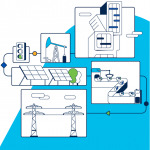With the passage of the Bipartisan Infrastructure Deal in November 2021, state and local governments are looking at transportation projects that will improve safety, simplify operations, and reduce traffic congestion and emissions. Connected technology should be at the centerpiece of your investments for critical infrastructure. In the first blog in this series, I described five high-value projects. (Cliff Notes version: video surveillance, connected traffic signal controllers, traffic signal priority and emergency vehicle pre-emption, dynamic message signs, and remote weather information systems.) In this blog I’ll summarize the kind of network you’ll need to introduce these programs.
Where are you starting?
Think of connected roadways and intersections as a four-stage journey:
- Unconnected infrastructure. If you’re here, you might have loops and timers, but they only connect to nearby equipment and can’t be monitored from a central operations center. Devices could be 20-30 years old.
- Basic connectivity. At this stage you’ve already started connecting equipment and sensors like traffic cameras, security cameras, traffic counters, or toll readers. Now you’re looking to expand to a larger area, or to remotely manage systems to improve safety or alleviate congestion. Many of our Department of Transportation (DOT) customers are at this point in their journey.
- Flexible and secure connectivity. Advanced use cases that improve safety and efficiency include e-tolling, dynamic signage, LiDAR detection of oncoming vehicles (e.g., to warn construction workers of a speeding car), e-ticketing, and detection of wrong-way drivers.
- Fully connected networks. The most advanced DOTs are introducing connected and autonomous vehicles, pedestrian safety projects like adding green light time for slow walkers, predictive analytics for vehicle fleets and traffic optimization. I talk more about those use cases here.
Is your network up to the task?
Here’s what you need to build a robust network to support intelligent transportation systems (ITS):
- Modern industrial network devices. Older networks and devices crumple under the demands of ITS. Technicians can’t see device status over the network, meaning they must drive to the field for routine maintenance. Traditional switches and routers aren’t designed to withstand harsh outdoor environments, including extreme temperatures, rain and snow. And existing DOT networks usually lack the bandwidth for video applications and connected automated vehicles. Our industrial Ethernet switches and 5G routers can connect to your legacy equipment, and are built to withstand extreme environmental conditions, and support high-bandwidth applications.
- Cyber and physical security protections. Equipment housed in roadside cabinets needs physical protection from bad actors. It also needs cybersecurity protections against attacks that could bring down the network or alter sensor data or responses. Use our network visibility tools to prevent unauthorized access by segmenting the network. For more detail, here’s a good blog on the physical and cyber security protections in our industrial switches and routers.
- Support for multiple access technologies. Depending on your use case, ITS like traffic signal controllers, cameras, and traffic counters might need to connect via fiber, LTE, 5G, or Cisco Ultra-Reliable Wireless Backhaul. Our industrial networking portfolio supports all of these access technologies.
- Replaceable communications modules for industrial routers. Order the router with the module you need today and swap it out if your needs change. That costs a lot less than replacing the entire router.
- Real-time data. Days-old or weeks-old data from cameras and sensors isn’t especially useful for taking steps to relieve traffic congestion. Additionally, paying a third party data provider for stale data can prove costly. You can identify real-time traffic patterns from cameras and sensors using our 5G portfolio and management solutions.
Build a modern traffic management center
We designed our industrial networking portfolio for intelligent transportation systems (ITS) with all of these requirements in mind. Our routers give you the flexibility to upgrade to a new communications technology (e.g., from 4G to 5G) without replacing the entire device. Our switches and routers are built to withstand extreme temperatures, rain, dust, and vibration. You get advanced physical and cybersecurity protections. Management tools like Cisco IoT Operations Dashboard let your operational technology (OT) teams manage your roadside infrastructure from anywhere—supporting remote work and helping you scale your connected roadways and intersections projects across an entire city, county, or state. With its Secure Equipment Access capability, it also enables you and your equipment partners and vendors to securely and remotely access the connected equipment without the need for truck rolls.
Take the next step in your journey
Get an IoT Operations Dashboard subscription free for one year when you purchase Cisco Catalyst IR1100 Rugged Series Routers.
Wherever you are along your journey, you can deploy faster and reduce risk with tested Cisco Validated Design implementation guides.
Watch the webinar on-demand: Connected Roads and Intersections Make Cities Safer, Reduce Congestion and Optimize Traffic Management
Learn more
- Cisco IoT Solutions for Connected Roadways and Intersections
- Connected Roadways and Intersections solution brief
- Infographic – Ready to connect the DoTs?
- Industrial routers and gateways
- Industrial switching
- Ultra-Reliable Wireless Backhaul
Subscribe to our newsletter to keep up with the latest Internet of Things trends and insights to help you succeed with your IoT deployments.

CONNECT WITH US